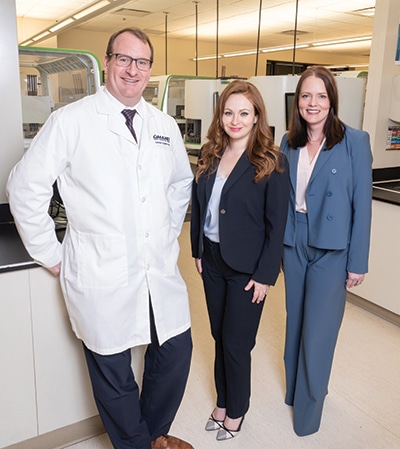Karen Titus
April 2023—After years of excitement and scientific breakthroughs, the use of molecular testing to guide cancer therapeutics finally is coming into its own. Unfortunately, it appears to have landed in the wrong place at the right time.
That place is a lonely spot, surrounded by gaps in economics and coverage, as well as knowledge, guidelines, ordering patterns, turnaround times, reporting, and the like. So plentiful are the gaps that, put together, they could form a vast, inhospitable space, a veritable Colorado Plateau, with molecular testing as a majestic, enticing but remote rocky pinnacle in the middle. Think Monument Valley.
It’s worth the trek. The evidence in support of genomic profiling continues to grow. Simply put, “Patients with the right markers who get the right drugs do better,” says Neal Lindeman, MD, vice chair, laboratory medicine and molecular pathology, Department of Pathology and Laboratory Medicine, Weill Cornell Medicine/New York Presbyterian Hospital.
But as numerous studies are showing, the lag in testing is growing as well. “Extensive, broad biomarker testing is not happening at nearly close to what would be an appropriate target,” says Samuel Caughron, MD, president, CEO, and director of the molecular pathology laboratory at MAWD Pathology Group, Lenexa, Kan. While no testing ever reaches 100 percent of patients, for those who would benefit, “We don’t even get close to getting [them] all tested.”
How did things end up here? What happened?
Or more to the point, what didn’t happen?
“Reimbursement,” says Dr. Lindeman.
“It’s a very complex issue,” says Dr. Caughron. There are, of course, operational and educational challenges. But most in the molecular field, he says, see another issue underpinning it all. When he travels the country and speaks with pathology groups, “I often hear economics as one of the major barriers, if not the most important variable, that prevents more patients from getting testing.”
A decade or so ago, the primary gap appeared to be the so-called town-gown split. Molecular cancer testing was expanding rapidly at academic centers and other large institutions that could afford to bring the tests (including next-generation sequencing) online, and whose faculty included experts and others heavily involved in research and clinical trials. Health care providers in community practice were the ones at risk of being left behind.Eventually, however—or so it was hoped—testing would come down in cost. NGS platforms would make their way to smaller labs. Knowledge and biomarkers would spread like dandelion fluff in the wind. And payers would see the affordable wisdom of making sure patients received the right treatments.
In the early days of the genomic era, Dr. Lindeman recalls, costs were relatively low for single-gene tests, such as EGFR testing for non-small cell lung cancer.
As panel testing became more common, “the costs went up an order of magnitude, and it became a financial issue. It was certainly a town-gown issue then,” says Dr. Lindeman, who until recently was affiliated with Dana-Farber/Harvard Cancer Center and Brigham and Women’s Hospital. There, he says, “We were a relatively early adopter of the panel testing approach, because the only places that could afford it were the tertiary care cancer centers and academic institutions that saw this as the future and were willing to take a loss on it.”

Dr. Samuel Caughron with Natasha Villanueva (center), VP of clinical laboratory, and Kathleen Little, VP of pathology operations, MAWD Pathology Group. “There is a significant lack of alignment,” Dr. Caughron says, between reimbursement and the pathologist’s role in molecular testing workups to guide cancer treatment. [Photo by: Don Ipock]
This goes beyond the usual suspects that affect molecular access. “Now there are market forces weighing in on this,” Dr. Lindeman says.
For example, “When we propose to do it now, the answer is, ‘Who’s going to pay for it?’ We didn’t have those conversations a decade ago. The institutions were willing to invest in it because they perceived it would be an interesting future development. Now that it’s a present development, the sense is the insurance companies should be paying for it—and they’re not.”
Dr. Lindeman also says he’s seen examples of Medicare paying for molecular cancer testing that private insurers won’t cover. “Which I find interesting.”
Delving deeper into the present, Dr. Lindeman describes a landscape in which some private companies offer deeply discounted testing in exchange for patient data, which can then be sold to pharmaceutical companies. “They are getting secondary value from resale and re-presentation of the data so that they don’t need to cover their costs with clinical billing.”And for physicians who don’t believe that their patients’ data should be repurposed in this way? Says Dr. Lindeman: “You’re stuck. That’s the deal you make with these companies.” Otherwise, “You have to figure out the cost of doing the work.”

Dr. Lindeman
Not many laboratories have. Major cancer centers, such as MD Anderson, Dana-Farber, and Memorial Sloan Kettering, have their own extensive testing programs, Dr. Lindeman says. Major academic centers continue to offer testing as well, but within smaller programs.
Some insurers are reimbursing for FDA-approved tests, but not laboratory-developed tests, which benefits a select number of commercial laboratories with ample resources and processes, Dr. Lindeman says. Many academic hospitals are essentially frozen out. This is the new town-gown paradigm, perhaps. “That has created—I’m not sure what to call the commercial labs—it’s sort of a business-gown conflict.”
Regulatory issues have further marooned testing, Dr. Lindeman suggests.
“We’re stuck in this model where the regulatory agencies are requiring a specific test for each drug,” he says. “And it’s a model that doesn’t scale or work terribly well.” Instead of an approach where test certification, clearance, or approval is predicated on detecting a specific analyte, with specific performance characteristics—sensitivity, specificity, precision, etc.—pathologists are limited to individual, branded assays that worked in the clinical drug trials. “That’s unsustainable for pathology organizations. It makes it harder for labs to offer tests,” Dr. Lindeman says. “And in the end, it denies access to patients.
“It’s an inhibitor of a molecule,” he continues. “Why not just get a test for that molecule to get any class of inhibitor, within a reasonable safety profile? I don’t want to tell the FDA how to manage drugs.” But the current model “has a chilling effect on access to testing and then, by extension, access to therapeutics.”
These wide gaps are starkly clear to Pranil Chandra, DO, as well. “Over the past decade or so, the field of molecular pathology has seen some pretty severe reimbursement as well as regulatory pressure,” says Dr. Chandra, senior vice president and chief genomics officer, PathGroup, Nashville, Tenn.He uses elephants to illustrate the problem—not the familiar trope of vision-impaired folks sussing out the mammal from different points; rather, it’s more of a pachyderm cocktail party. When it comes to addressing the gaps in molecular testing, “there are a lot of elephants in the room,” says Dr. Chandra.
One of the larger elephants, he says, is inconsistent, highly variable coverage by payers, which has an impact on equitable access to care. “Ultimately, in our experience, most of the time the testing gets done,” Dr. Chandra says. “But it’s with a lot of difficulty.”
Dr. Chandra says he’s seen improvements in payer coverage policies by certain payers, but that noncovered status with many payers affects significant populations in the United States.
In his experience, private payers may be informed by their own medical directors who are unfamiliar with molecular pathology and cancer genomics testing. Medical policy decisions may be outsourced, Dr. Chandra continues, stoking requirements for prior authorization.
“Things are getting better,” he says, “but the fact of the matter remains: There is a lack of standardization amongst third-party commercial payers, and many of them are kind of doing their own thing.”
Some elephants are especially unruly. “With certain carriers, we’ve noticed they do not pay for testing, even for tests that are recommended in medical guidelines,” Dr. Chandra says. “That’s starting to become an issue. We have to ensure that people have equitable access to care.”
A potential solution could occur on the state legislative level, Dr. Chandra says. In some states, lawmakers are requiring insurers to pay for biomarker testing that is recommended by medical guidelines. Such an approach is especially appealing, he says, because it democratizes access to testing as well as to therapies.
These larger forces exert specific pressures on pathologists and laboratories. “There is a significant lack of alignment,” Dr. Caughron says, between reimbursement and the pathologist’s role in molecular workups.He, too, digs into historical roots to explain current problems. The professional component of biomarker testing has never been on par with other anatomic pathology work. “With genomics, because it’s done in a test tube, instead of through the microscope, we limit it,” he says.
With the reimbursement for professional work minimal or nonexistent, he says, “any time the pathologist spends on this is unpaid time.”
“When that problem is solved, and pathologists can justify the time they spend on the issue, then they can give that time,” he says, noting that ER, PR, and HER2 testing became commonplace when testing was compensated appropriately.
That may not happen as easily with other cancer biomarkers, he concedes, given that molecular biomarkers straddle both clinical laboratory tests and anatomic pathology tests. (“Though I disagree a little bit with the use of those terms,” he adds.) When the CMS put molecular tests onto the clinical lab fee schedule, that removed a separately valued professional service. “What we need to be successful is for them to be more like pathology tests,” he says.
Teasing out that analogy a bit more, he says there’s every reason to test most tumors, especially advanced ones, with extensive molecular workups to guide treatment. “Why wouldn’t we use our tools to gain that information?” Dr. Caughron asks. “We don’t look through a microscope and just say, OK, we found the part that has invasion, so we’re not going to look anywhere else.”
At one point, it looked like NGS would be the one-size-fits-most solution, allowing for identification of multiple rare markers. It could still happen, says Dr. Caughron. “But it’s still a volume game—you need to have a certain volume to make it not economically catastrophic. And there’s still the problem of the time the pathologist has to spend on this. Nowhere in the system is that time appropriately counted for and reimbursed.”
It can work for large reference labs, Dr. Caughron says. But in smaller settings, even when it’s possible to show overall cost savings to the institution, “How do you move some of that to the pathologist, who makes it all possible? Without a direct payment model, it can be very difficult for that to happen,” given that with most hospitals, there remains a direct correlation between the professional services provided and how physicians are paid. In this view, the molecular gap is actually the gap in the professional reimbursement. When the system figures out how to close that gap, he says, “I think you’d find many pathologists who suddenly become interested in bringing this into their laboratory and spending time on it.”
Ideally, practice guidelines that call for molecular testing would light a way through the wilderness. But again, there’s no easy path, says Dr. Lindeman. While the NCCN guidelines, for example, have no shortage of molecular tests, “they’re often miscellaneous recommendations—category 2A. They’re not always baked into the algorithm per se,” he says. Moreover, guidelines for working up a case from a diagnostic perspective are a bit more rudimentary compared with treatment guidelines, he observes.In a tidy world, testing could easily be divided into diagnostic, prognostic, and therapeutic columns. But biomarkers fail to heed the divisions craved by the medical profession and insurers. “It’s becoming very hard to distinguish” what a biomarker’s utility is, Dr. Chandra says. “Those three uses overlap,” to the consternation of payers who are laser-focused on so-called actionable biomarkers.
 CAP TODAY Pathology/Laboratory Medicine/Laboratory Management
CAP TODAY Pathology/Laboratory Medicine/Laboratory Management
